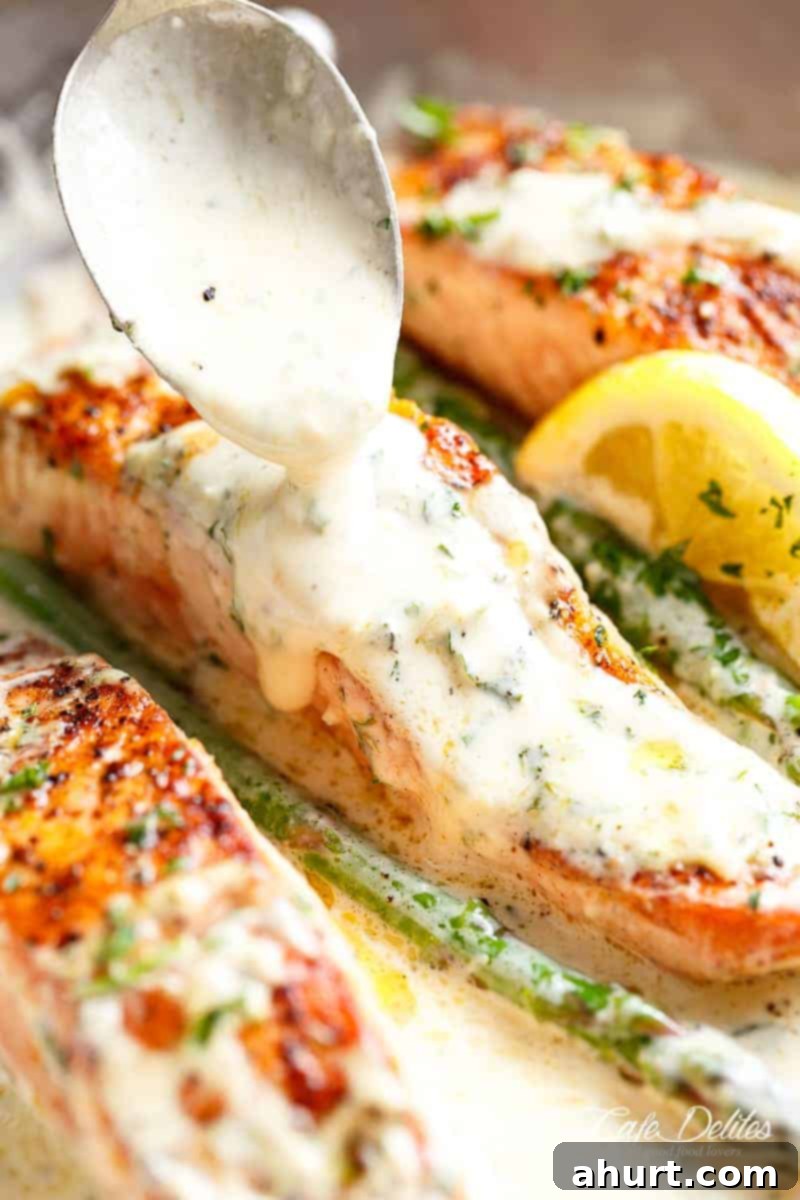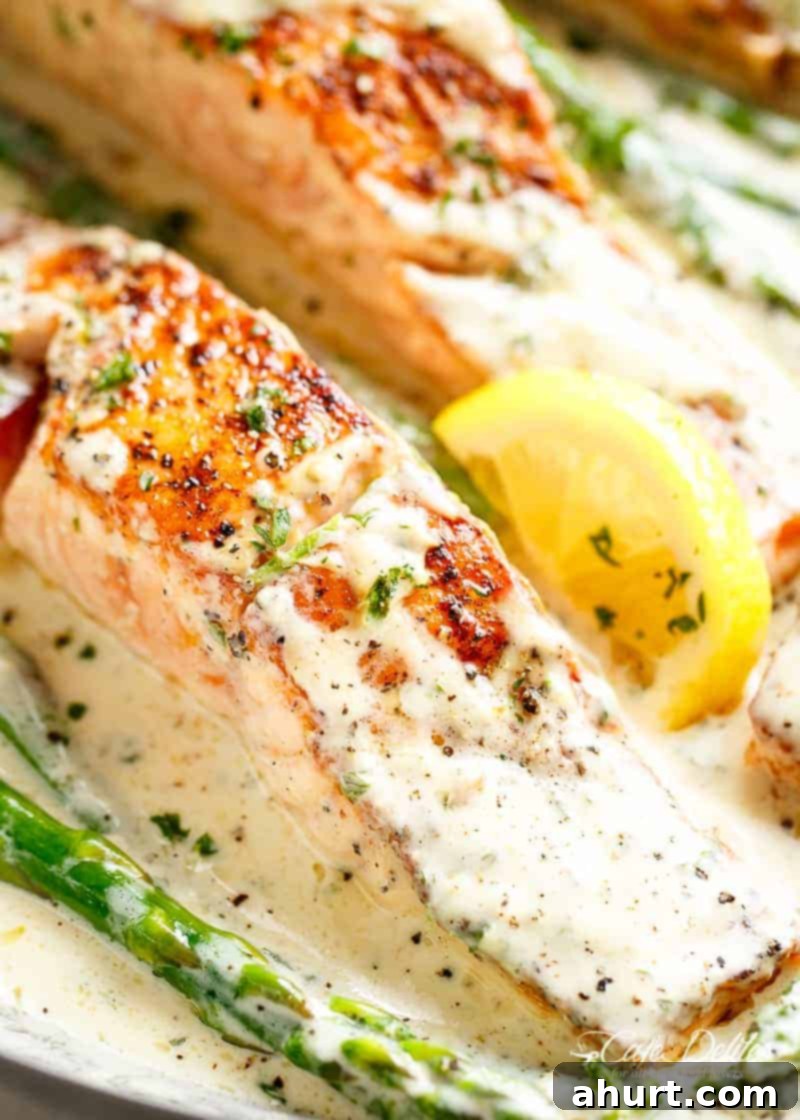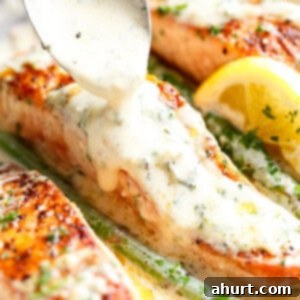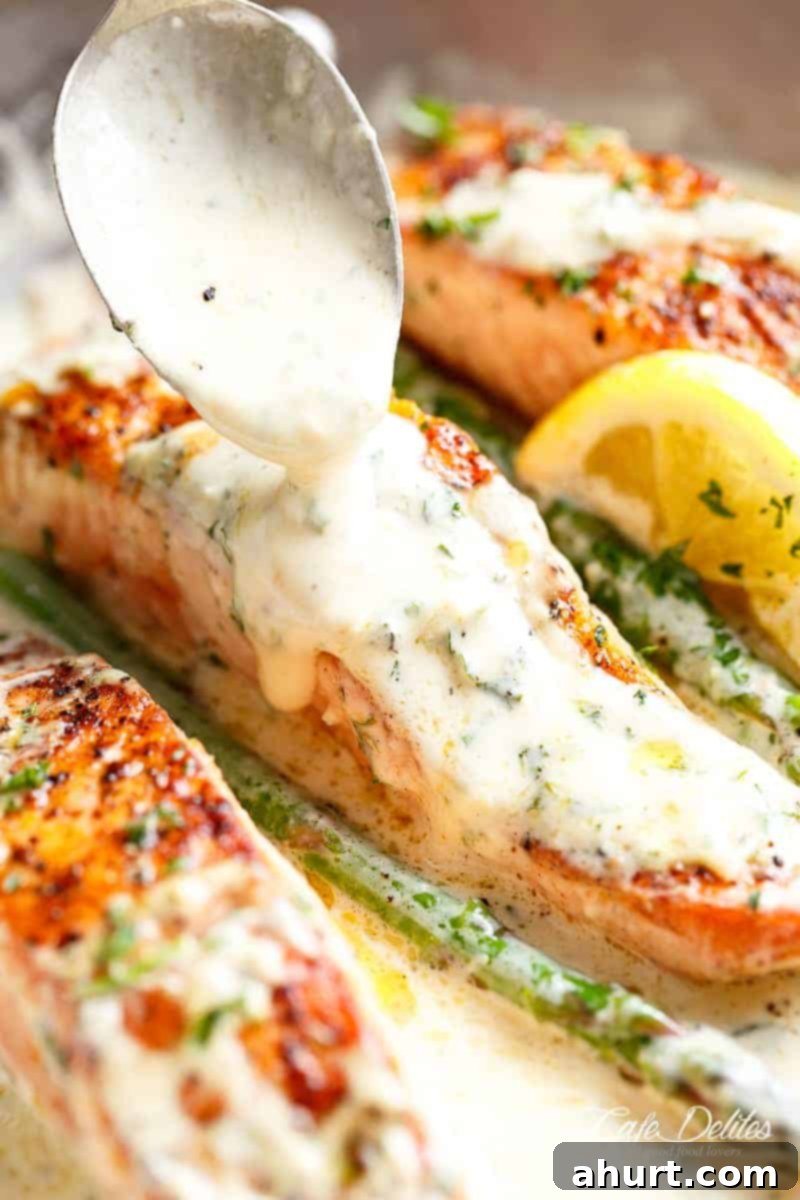Creamy Dijon Salmon: Your Ultimate One-Pan Weeknight Dinner
Creamy Dijon Salmon is a true culinary gem – a meal that offers the elegance of a restaurant dish with the simplicity of a quick weeknight dinner. Imagine perfectly pan-seared salmon fillets, crispy on the edges and beautifully flaky in the center, generously coated in a rich, velvety garlic and herb Dijon sauce. This exquisite sauce is so incredibly addictive, you’ll find yourself wanting to spoon it over every component of your plate! Not only is this dish incredibly flavorful and satisfying, but it’s also low-carb and keto-friendly, making it a wholesome choice for any diet.
This Dijon salmon recipe transforms weeknight cooking into an effortless joy. Each salmon fillet is seasoned to perfection and pan-fried until it reaches that ideal balance of crisp exterior and buttery, tender interior. The luscious creamy Dijon sauce is not merely an accompaniment; it’s a star in its own right, enhancing the salmon’s natural richness and pairing beautifully with the vibrant asparagus cooked right alongside it in the same pan. With its simple ingredients, minimal prep time, and explosion of flavor, this easy creamy Dijon salmon is destined to become a staple in your home – a dish everyone will eagerly request again and again. It’s the kind of meal that makes healthy eating feel like a luxurious indulgence.

Why You’ll Love This Creamy Dijon Salmon Recipe
This **Creamy Dijon Salmon** recipe is the epitome of culinary harmony, blending ease with elegance in every bite. The salmon is expertly pan-fried, achieving a gorgeous golden crust and a succulent, flaky texture that melts in your mouth. But the real magic happens when it’s enveloped in a rich, creamy garlic and herb sauce, infused with the distinctive tang of Dijon mustard. This sauce doesn’t just coat the fish; it elevates its natural flavors, creating a symphony for your taste buds. With minimal preparation and a selection of everyday ingredients, this recipe proves that a quick and easy meal can absolutely rival a dish served in a fine dining restaurant.
The true brilliance of this Dijon salmon recipe lies within its perfectly balanced sauce. The sharp, piquant notes of Dijon mustard cut through the richness of the heavy cream and butter, resulting in an exquisitely velvety sauce that clings beautifully to every forkful of salmon and tender asparagus. This versatile creamy Dijon sauce transforms fresh salmon into an unforgettable experience, solidifying this recipe as a go-to choice for both busy weeknight dinners and more festive special occasions. Its one-pan nature also means less cleanup, a definite bonus for any home cook.
Key Reasons to Make This Easy Salmon Dish:
- Effortlessly Elegant: Tastes gourmet but is incredibly simple to prepare, perfect for impressing guests or a fancy meal at home.
- Quick & Convenient: Ready in under 30 minutes, ideal for busy weeknights when time is of the essence.
- One-Pan Wonder: Salmon and asparagus cook together, minimizing cleanup and maximizing flavor.
- Rich & Creamy Flavor: The garlic and herb Dijon sauce is irresistibly delicious and coats everything beautifully.
- Healthy & Wholesome: Packed with omega-3 fatty acids from salmon, lean protein, and fresh vegetables. It’s also low-carb and keto-friendly.
- Versatile: Easily adaptable with different vegetables or herbs to suit your preference.
Essential Ingredients for Your Creamy Dijon Salmon
This Creamy Dijon Salmon recipe relies on simple, readily available ingredients that, when combined, create a truly spectacular and flavorful meal. Each component plays a crucial role in achieving the perfect balance and texture.
- Salmon Fillets: The star of the dish! Opt for fresh, high-quality salmon. You can use skin-on or skinless fillets – skin-on often yields a crispier exterior and holds shape better. Look for vibrant, moist flesh without any strong fishy odor. Salmon is not only delicious but also packed with essential omega-3 fatty acids, making this a healthy choice.
- Dijon Mustard: This is the heart of our creamy sauce. Authentic Dijon mustard provides a distinctively tangy and slightly spicy flavor that beautifully cuts through the richness of the cream. You can adjust the amount to your taste, or even experiment with whole-grain Dijon for added texture.
- Heavy Cream: Essential for creating that incredibly silky, luxurious texture of the Dijon sauce. It helps the sauce cling perfectly to both the tender salmon and crisp asparagus, ensuring every bite is rich and satisfying. For a slightly lighter version, half-and-half can be used with care to avoid curdling.
- Asparagus: This vibrant green vegetable adds a fresh, slightly crisp texture and a delicate flavor that complements the salmon and sauce wonderfully. Cooking it directly in the pan with the sauce infuses it with flavor and makes this a true one-pan meal. Choose firm, bright green stalks with tight tips.
- Olive Oil & Unsalted Butter: A combination used for searing the salmon and building the flavor base for the sauce. Olive oil provides a high smoke point, while butter adds rich, nutty notes.
- Garlic: Freshly minced garlic is crucial for aromatic depth in the creamy sauce, adding a robust and savory foundation.
- Low-Sodium Chicken Stock (or Broth): Used to deglaze the pan and create a flavorful base for the sauce, capturing all those delicious browned bits from the salmon.
- Fresh Parsley: Adds a pop of fresh, herbaceous flavor and a beautiful green garnish. You can also experiment with other fresh herbs like dill or chives.
- Basic Seasonings: Salt, black pepper, garlic powder, and paprika are used to season the salmon, enhancing its natural flavor and adding a subtle warmth.
- Lemon Wedges: Served alongside, a squeeze of fresh lemon juice at the end brightens the entire dish and adds a zesty finish.
Note: Please see the recipe card at the bottom for a full list of ingredients with precise measurements.
Step-by-Step: How to Prepare Creamy Dijon Salmon
Creating this delicious Creamy Dijon Salmon is surprisingly simple, even for novice cooks. Follow these clear steps to achieve perfect results every time.
- Prepare and Season the Salmon: Begin by thoroughly patting your salmon fillets dry with paper towels. This crucial step helps ensure a crispy sear. Season generously and evenly on all sides with salt, freshly cracked black pepper, garlic powder, and a touch of paprika for color and mild flavor.
- Heat the Pan: In a large, heavy-bottomed skillet (cast iron or stainless steel works best), warm the olive oil and butter over medium-high heat. Wait until the butter is melted and the oil is shimmering and just starting to smoke slightly – this indicates the pan is hot enough for a good sear.
- Sear the Salmon: Carefully place the seasoned salmon fillets into the hot skillet, flesh-side down first (skin-side up if your fillets have skin). Cook undisturbed for about 5 minutes, or until the salmon is cooked about halfway through and you see a golden-brown crust forming. Flip the fillets and continue cooking for another 3-4 minutes, or until the salmon is flaky and cooked to your desired doneness. If your pan is crowded, cook the salmon in batches to ensure proper searing.
- Remove Salmon and Preserve Juices: Once the salmon is perfectly cooked, transfer it carefully to a plate. It’s essential to leave all those flavorful pan juices and browned bits in the skillet – these are the foundation of our delicious Dijon sauce!
- Build the Sauce Base: Return the same skillet to medium-high heat. Add another tablespoon of butter and melt it in the remaining pan juices. Sauté the minced garlic until it becomes fragrant, which typically takes about 30 seconds to a minute. Pour in the chicken stock and bring it to a simmer, allowing the liquid to reduce by half. Make sure to scrape up all the delicious browned bits (fond) from the bottom of the pan – this adds immense depth of flavor to your sauce.
- Create the Creamy Dijon Sauce: Reduce the heat slightly to low-medium. Whisk in the Dijon mustard, heavy cream, and chopped fresh parsley. Stir continuously until the sauce is smooth, well combined, and begins to thicken gently.
- Incorporate Asparagus: Add the trimmed asparagus stalks to the simmering sauce. Continue to simmer gently, stirring occasionally, until the asparagus is tender-crisp and the creamy Dijon sauce has thickened to your desired consistency. Taste the sauce and adjust seasonings (salt and pepper) if needed.
- Finish and Serve: Gently return the cooked salmon fillets to the pan, nestling them into the rich sauce and coating them lightly. A final sprinkle of fresh parsley adds brightness. Serve immediately with fresh lemon wedges on the side for a burst of citrus flavor. Enjoy your perfectly cooked Creamy Dijon Salmon!
Serving Suggestions for Your Creamy Dijon Salmon
This Creamy Dijon Salmon is incredibly satisfying on its own, especially with the asparagus cooked in the pan. However, for a more complete and diverse meal, consider these delicious pairings:
- Elegant Side: To keep things refined yet simple, Prosciutto Wrapped Asparagus makes a perfect accompaniment. The salty crispness of the prosciutto beautifully highlights the creamy Dijon sauce, while the extra asparagus complements the vegetables already in the pan.
- Comforting Option: If you’re craving something cozy and hearty, a light soup like Slow Cooker Creamy Gnocchi Sausage Kale Soup (served in smaller portions) adds a warm, comforting element without overpowering the delicate salmon.
- Light & Fresh Pasta: For a lighter but equally satisfying side, One Pot Orzo Primavera brings fresh vegetables and delicate pasta that will lovingly soak up every drop of that irresistible creamy Dijon sauce.
- Simple Carbohydrates: Pair with fluffy white rice, brown rice, quinoa, or couscous to absorb the delectable sauce.
- Creamy Mash: Garlic mashed potatoes or cauliflower mash (for a low-carb option) offer a delightful texture contrast and soak up the sauce beautifully.
- Roasted Vegetables: Beyond asparagus, consider roasted broccoli, green beans, or Brussels sprouts for an additional healthy and flavorful side.
- Fresh Salad: A simple green salad with a light vinaigrette can provide a refreshing counterpoint to the richness of the salmon and sauce.
Recipe FAQs for Creamy Dijon Salmon
Absolutely! You can use salmon with or without skin for this recipe. Skin-on fillets are often preferred as the skin crisps up beautifully when seared, adding a wonderful textural contrast, and it also helps the fillet hold its shape better during cooking.
Traditional smooth Dijon mustard is highly recommended as it provides the sauce with its classic tangy and slightly sharp flavor profile, contributing to its creamy texture. However, for those who enjoy a bit of texture and a milder tang, whole grain Dijon mustard can also be an excellent choice. Avoid regular yellow mustard as its flavor profile is quite different.
Perfectly cooked salmon should flake easily with a fork when gently pressed in the thickest part. The flesh should be opaque throughout, with a slightly translucent center if you prefer it medium-rare. For precise cooking, use an instant-read thermometer; the internal temperature should reach 145°F (63°C) at its thickest point. Overcooked salmon tends to be dry, so it’s best to err on the side of slightly undercooked rather than overcooked.
Yes, you can. Ensure the salmon is fully thawed overnight in the refrigerator or using cold running water. Pat it very dry with paper towels before seasoning and cooking, as excess moisture can prevent a good sear.
If your creamy Dijon sauce is thinner than desired, you can easily thicken it. In a small bowl, whisk together 1 teaspoon of cornstarch with 1 tablespoon of cold water until smooth. Stir this slurry into the simmering sauce in the pan and continue to cook for another minute or two, stirring constantly, until the sauce reaches your preferred consistency.
Absolutely! This recipe is quite versatile. Great alternatives to asparagus include green beans, broccoli florets, spinach (add at the very end as it wilts quickly), or even cherry tomatoes for a burst of color and sweetness. Adjust cooking times based on the vegetable you choose.


Saved
Pin
Creamy Dijon Salmon
Karina
10 minutes
10 minutes
20 minutes
4
people
Ingredients
FOR SALMON:
-
1 tablespoon olive oil -
1 tablespoon unsalted butter -
21 ounces salmon filets skin on or off -
1 pinch salt to taste -
1 pinch cracked pepper to taste -
1 teaspoon garlic powder -
1/2 teaspoon mild paprika
FOR CREAMY DIJON SAUCE:
-
1 tablespoon unsalted butter -
4 cloves garlic minced -
3/4 cup low-sodium chicken stock or broth -
1 cup heavy cream or half and half -
1 heaped tablespoon Dijon mustard adjust to your taste -
2 tablespoons fresh parsley chopped -
1 pound asparagus stalks woody ends trimmed -
3 lemon wedges to serve
Instructions
-
Pat salmon dry with paper towel. Season salmon all over with salt, pepper, garlic powder and paprika.
-
Heat oil and butter in a large skillet over medium-high heat until hot. Sear flesh-side down first (skin-side up), for 5 minutes or until cooked halfway up. Flip and cook for a further 3-4 minutes or until cooked to your liking. (Cook in batches of two if needed to avoid overcrowding your pan.)
-
Once cooked, remove salmon from the pan and set aside. KEEP all of the flavourful juices in the pan.
-
Return pan to medium-high heat and melt the butter in the juices. Sauté garlic until fragrant (about 30 seconds), then pour in the stock. Allow liquid to reduce to half while scraping browned bits from the bottom of the pan.
-
Reduce heat to low-medium heat. Whisk in the Dijon mustard, cream and parsley. Add the asparagus and bring to a gentle simmer, while stirring occasionally, until asparagus is cooked and sauce has thickened. Season with salt and pepper to your taste.
-
Add the salmon back into the pan, sprinkle with parsley, taste test sauce and adjust salt and pepper, if needed.
-
Serve.
Notes & Expert Tips
For an extra layer of sophisticated flavor, consider substituting the low-sodium chicken stock (or broth) with a good quality dry white wine. A Pinot Grigio or Chardonnay works beautifully, adding depth and a subtle acidity to the Dijon sauce. Allow the wine to reduce by half to cook off the alcohol and concentrate the flavors.
Cream Alternatives:
While heavy cream provides the richest, most luxurious sauce, you can opt for half-and-half for a slightly lighter version. If using half-and-half, be extra careful not to bring the sauce to a rolling boil, as it has a lower fat content and is more prone to curdling. Evaporated milk can also be used as a low-calorie substitute, offering a creamy texture without the high fat content.
Herb Variations:
Parsley adds a classic fresh note, but feel free to experiment with other fresh herbs to customize the flavor profile. Dill is a fantastic pairing with salmon, offering a bright, slightly anise-like flavor. Other great options include fresh basil, oregano, chives, or a hint of thyme. Chop them finely and add them in at the end for the best aroma.
Achieving a Thicker Sauce:
If you prefer a thicker sauce, an easy trick is to create a cornstarch slurry. In a small bowl, whisk 1 teaspoon of cornstarch with 1 tablespoon of cold water until thoroughly combined and free from lumps. Once your sauce is simmering, stir this slurry gradually into the center of the pan. Continue stirring gently until the sauce has thickened to your desired consistency. Avoid adding cornstarch directly to hot liquid to prevent lumps.
Expert Tips for Cooking Perfect Salmon:
- Skin On or Off: You can use either skin-on or skinless fillets. Skin-on often provides a crispier texture and helps the fish maintain its shape.
- Room Temperature Start: For more even cooking, remove your salmon from the refrigerator about 15 minutes before you plan to cook it. This allows the fillets to come closer to room temperature, preventing the outside from overcooking before the inside is done.
- Pat Dry Thoroughly: Always pat the salmon fillets very dry with paper towels. Excess moisture on the surface prevents proper searing and crust formation, leading to a steamed rather than crispy finish.
- Hot Pan is Key: Ensure your skillet (preferably cast iron or a heavy-bottomed pan) is hot before adding the salmon. Heat the olive oil and butter until shimmering. A hot pan creates a beautiful, flavorful crust quickly.
- Season Just Before Cooking: Season your salmon right before it goes into the hot pan. Salting too early can draw moisture out of the fish, potentially drying it out.
- Sear Undisturbed: Place the salmon flesh-side down first (skin-side up if applicable) and resist the urge to move it! Pan-fry your fillets — UNTOUCHED — until they are cooked about halfway to three-quarters of the way up the side. This allows a delicious crust to form. Then, flip once and cook for the remaining time.
How to Store Leftovers:
- Cooked Creamy Dijon Salmon can be stored in an airtight container in the refrigerator for up to 3 days. Reheat gently in a skillet over low heat or in the microwave to prevent drying out the salmon. Adding a splash of broth or cream can help revive the sauce.
Nutrition
Calories:
537
kcal
|
Carbohydrates:
10
g
|
Protein:
35
g
|
Fat:
41
g
|
Saturated Fat:
19
g
|
Polyunsaturated Fat:
5
g
|
Monounsaturated Fat:
13
g
|
Trans Fat:
0.2
g
|
Cholesterol:
164
mg
|
Sodium:
113
mg
|
Potassium:
1.112
mg
|
Fiber:
3
g
|
Sugar:
4
g
|
Vitamin A:
2.262
IU
|
Vitamin C:
17
mg
|
Calcium:
101
mg
|
Iron:
4
mg
Nutrition information is automatically calculated, so should only be used as an approximation.
Tried this? Leave a comment below!
